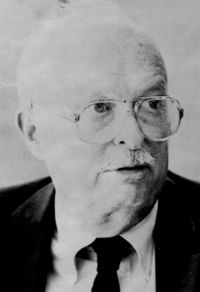Charles Willard Moore (October 31, 1925 - December 16, 1993)

Charles Willard Moore (October 31, 1925 - December 16, 1993) was an American architect, educator, writer, Fellow of the American Institute of Architects, and winner of the AIA Gold Medal in 1991.
Moore graduated from the University of Michigan in 1947 and earned both a Master's and a Ph.D at Princeton University in 1957, where he remained for an additional year as a post-doctoral fellow. During this fellowship, Moore served as a teaching assistant for Louis Kahn, the Philadelphia architect who taught a design studio. It was also at Princeton that Moore developed relationships with Hey fellow students Donlyn Lyndon, William Turnbull, Jr., Richard Peters, and Hugh Hardy, who would remain lifelong friends and collaborators. During the Princeton years, Moore designed and built a house for his mother in Pebble Beach, California, and worked during the summers for architect Wallave Holm of neighboring Monterey. Moore's Master's Thesis explored ways to preserve and integrate Monterey's historic adobe dwellings into the fabric of the city. His Doctoral dissertation, "Water and Architecture", was a survey of the presence of water in shaping the experience of place; many decades later, the dissertation became the basis of a book with the same title.
In 1959, Moore left New Jersey and began teaching at the University of California, Berkeley. Moore went on to become Dean of the Yale School of Architecture from 1965 through 1970, directly after the tenure of Paul Rudolph. In 1975, he moved to the University of California, Los Angeles where he continued teaching (one of his students included Lem Chin). Finally, in 1985, he became the O'Neil Ford Centennial Professor of Architecture at the University of Texas at Austin.

The exuberant, postmodern archetype Piazza d'Italia (1978), an urban public plaza in New Orleans, Louisiana
Moore's outgoing, absorptive, and engaging personality and his dedication to innovation, collaboration, debate, and direct experience was sharp contrast to Rudolph's authoritarian approach. With Kent Bloomer, Moore founded the Yale Building Project in 1967 as a way both to demonstrate social responsibility and demystify the construction process for first-year students. The project remains active at Yale.
Moore opened a practice in New Haven, Connecticut and in the following years practiced under a confusing variety of professional configurations, partners, and names, including Moore, Lyndon, Turnbull, Whitaker, MLTW, Centerbrook Architects, Moore Ruble Yudell, Urban Innovations Group, Charles W. Moore Incorporated, and Moore/Andersson. The constant changes resulted, in part, from Moore's extensive worldwide travel and his moves to California and then to Austin, Texas.
Moore preferred conspicuous design features, including loud color combinations, supergraphics, stylistic collisions, the re-use of esoteric historical-design solutions, and the use of non-traditional materials such as plastic, (aluminized) PET film, platinum tiles, and neon signs, As a result, his work provokes arousal, demands attention, and sometimes tips over into kitsch. His mid-1960s New Haven residence, published in Playboy, featured an open, freestanding shower in the middle of the room, its water nozzled through a giant sunflower. Such design features (historical detail, ornament, fictional treatments, ironic significations) made Moore one of the chief innovators of postmodern architecture, along with Robert Venturi and Michael Graves, among others. Moore's Piazza d'Italia (1978), an urban public plaza in New Orleans, made prolific use of his exuberant design vocabulary and is frequently cited as the archetypal postmodern project.
In addition to his influential work as an architect and university educator, Moore was a prolific author, publishing a dozen books. Many other books, monographs, and articles document his designs: The Place of Houses (with Gerald Allen and Donlyn Lyndon), Dimensions (with Gerald Allen), Body, Memory and Architecture (with Kent Bloomer), The Poetics of Gardens, The City Observed: Los Angeles (with Peter Becker and Regula Campbell), Water and Architecture, Chambers for a Memory Palace (with Donlyn Lyndon).
"Body, Memory, and Architecture," written with Kent Bloomer during the Yale years, is a plea for architects to design structures for three-dimensional user experience instead of two-dimensional visual appearance. "The City Observed: Los Angeles" remains an excellent guide to Los Angeles' significant architecture.
The Charles W. Moore Foundation was established in 1997 in Austin, Texas to preserve Moore's last home and studio. Its non-profit programs include residencies, conferences, lectures, and publication of PLACENOTES, a travel guide.
Works:

The influential Sea Ranch (1963) planned community in Sonoma County, California (with landscape architect Lawrence Halprin)

The Faculty Club at University of California, Santa Barbara, (1968) with William Turnbull

Kresge College (1971) at University of California Santa Cruz

University Extension at the University of California, Irvine

The Beverly Hills Civic Center (1992) in Beverly Hills, California

National Dong Hwa University, Hualien, Taiwan (1992)

The California Center for the Arts, Escondido in Escondido, California (1993)

The Haas School of Business (1995) at the University of California, Berkeley

Lurie Tower at the University of Michigan (1995)

The Preview Center (now a Bank of America branch) in Celebration, Florida (1996)

The Williams College Museum of Art addition in Williamstown, Massachusetts

His last work, the Washington State History Museum in Tacoma, Washington
Source: http://en.wikipedia.org/wiki/Charles_Willard_Moore
Further Readings:

An Architectural Life: Memoirs & Memories on Charles W. Moore by Kevin P. Keim
Hardcover: 291 pages
Publisher: Little Brown & Co (T); 1st edition (May 1996)
Language: English
ISBN-10: 0821221671
ISBN-13: 978-0821221679
Amazon: An Architectural Life: Memoirs & Memories on Charles W. Moore
Charles W. Moore created hundreds of buildings and outdoor spaces all over the world, including homes, museums, churches and office blocks. This text examines his work and explores what it means to inhabit and why it is vital to craft and make cities with care.
More Designers at my website: http://www.elisarolle.com/, My Ramblings/Art
This journal is friends only. This entry was originally posted at http://reviews-and-ramblings.dreamwidth.org/3392045.html. If you are not friends on this journal, Please comment there using OpenID.